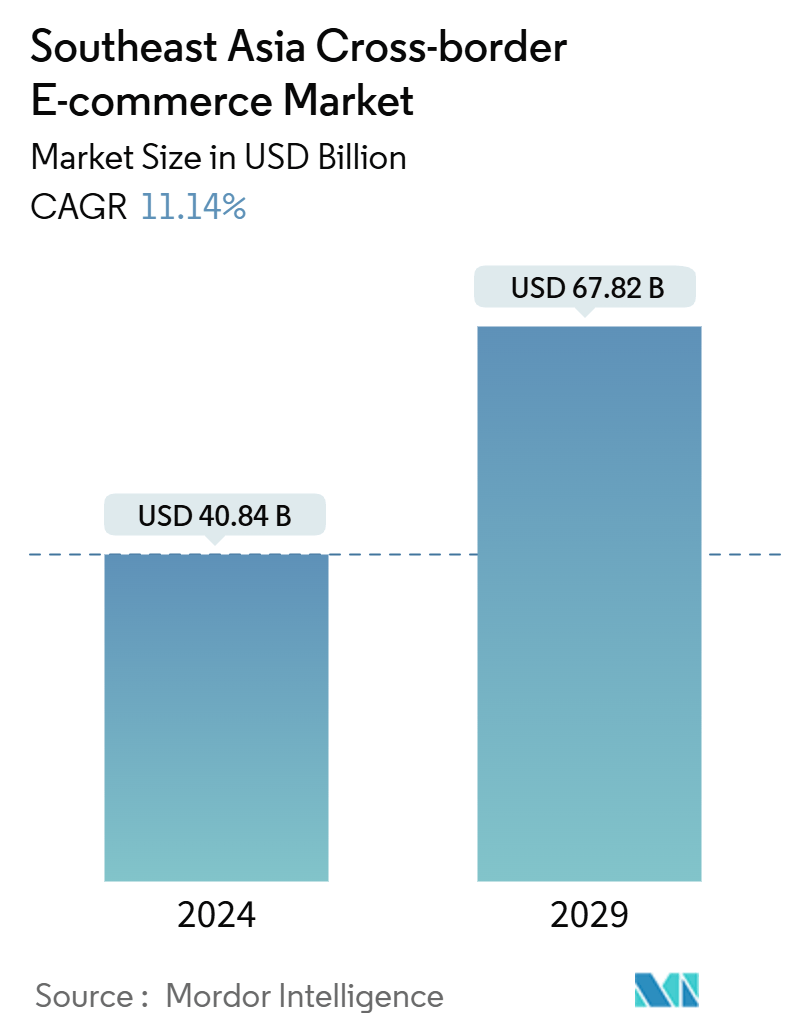
| Study Period | 2020 - 2029 |
| Base Year For Estimation | 2023 |
| Forecast Data Period | 2024 - 2029 |
| Market Size (2024) | USD 40.84 Billion |
| Market Size (2029) | USD 67.82 Billion |
| CAGR (2024 - 2029) | 11.14 % |
| Market Concentration | Low |
Major Players
*Disclaimer: Major Players sorted in no particular order |
Southeast Asia Cross-border E-commerce Market Analysis
The Southeast Asia Cross-border E-commerce Market size is estimated at USD 40.84 billion in 2024, and is expected to reach USD 67.82 billion by 2029, at a CAGR of 11.14% during the forecast period (2024-2029).
Cross-border e-commerce is the global market's future. The increasing ease of logistics has made buying or selling overseas a viable and intriguing option for people worldwide. Southeast Asia is the hotspot for global e-commerce goods. Southeast Asians have demonstrated a strong interest in cross-border trade. The following are fascinating facts about Southeast Asian countries' participation in the cross-border e-commerce market. Singapore and Malaysia account for roughly half Southeast Asia's cross-border e-commerce market. Thailand's e-commerce market is rapidly expanding. The Thailand 4.0 policy aims to improve internet access in every village nationwide. By introducing more innovative and niche products, Vietnam and the Philippines demonstrated significant cross-border potential.
Customers' demand and the viability of manufacturers sourcing products or services have been the primary drivers of emerging cross-border e-commerce. Furthermore, Southeast Asia has seen the highest population growth, with more income, handy tech in their pockets, and better internet connectivity; the region has more active users than the United States or Japan, paving the way for competitive e-commerce. In parallel, factors such as the desire for higher quality at a lower cost and the scarcity of products in the domestic market are driving the growing popularity of cross-border e-commerce trading. Manufacturers see these factors as an opportunity to expand into new geographies, particularly Southeast Asia, to broaden their overall clientele base for business sales.
Cross-border e-commerce is expected to grow faster than the overall E-commerce market, particularly in Southeast Asia. Because of the crowded population, rising disposable income, internet users, smartphone usage, and infrastructure improvements, among other factors, logistics services have developed more efficiently and rapidly. Southeast Asia cross-border E-commerce is thriving, and taking advantage of niche products, low prices, high-quality goods, and other factors is driving up demand for this E-commerce market. Furthermore, cross-border E-commerce faces numerous challenges, such as high delivery costs, short delivery deadlines, currency, language, etc. Again, online payments are hampered in some countries due to a need for bank accounts.
For example, proper product advertising and marketing are set to become significant points of emphasis, as the e-commerce industry has suffered dramatically from product returns and refunds. Smaller e-commerce brands will invest more in current product campaigns, as accurate product representation may deter rising product return rates. Within this, e-commerce operators are likely interested in mixed-media promotion or a hybrid of static and video campaigns. Smaller e-commerce brands will also consider the consumer-seller relationship in 2023. E-commerce sellers may attempt to personalize a buyer's shopping experience to avoid fast and impersonal consumer goods transactions in e-commerce.
Southeast Asia Cross-border E-commerce Industry Segmentation
Cross-border e-commerce is defined as selling goods to another party from the website of a national store in another country. Cross-border e-commerce can occur between a retailer or brand and a consumer (B2C), two businesses (B2B), or two private individuals. A complete background analysis of the Southeast Asia cross-border e-commerce market, including the assessment of the economy and contribution of sectors in the economy, market overview, market size estimation for key segments, and emerging trends in the market segments, market dynamics, and geographical trends, and COVID-19 impact, is covered in the report.
The Southeast Asia cross-border e-commerce market is segmented by business (B2B and B2C), product (fashion and apparel, consumer electronics, home appliances, furniture, beauty and personal care products, and other products (toys, food products, etc.)), and country (Singapore, Thailand, Vietnam, Indonesia, Malaysia, Philippines, and Rest of Southeast Asia). The report offers market size and forecasts for all the above segments in value (USD).
| B2B |
| B2C |
| Fashion and Apparel |
| Consumer Electronics |
| Home Appliances |
| Furniture |
| Beauty and Personal Care Products |
| Other Products (Toys, Food Products, etc.) |
| Singapore |
| Thailand |
| Vietnam |
| Indonesia |
| Malaysia |
| Philippines |
| Rest of South East Asia |
Southeast Asia Cross-border E-commerce Market Size Summary
The Southeast Asia cross-border e-commerce market is experiencing significant growth, driven by the rise of social commerce and investments in logistics infrastructure. This region has become a focal point for global e-commerce, with countries like Singapore and Malaysia leading the charge. The increasing ease of logistics has made international trade more accessible, attracting a large number of consumers and manufacturers to participate in cross-border transactions. The demand for higher quality products at lower prices, coupled with the scarcity of certain goods in domestic markets, has further fueled this trend. Southeast Asia's burgeoning population, rising disposable incomes, and widespread internet connectivity have created a fertile ground for e-commerce expansion, making it a competitive landscape for global players.
The market is characterized by a fragmented landscape with numerous local and regional players such as Shopee, Lazada, Tokopedia, Qoo10, and Bukalapak dominating the scene. These platforms leverage social commerce to enhance consumer engagement and drive sales, offering a seamless shopping experience that integrates social media interactions. Despite challenges like high delivery costs and payment barriers, the market continues to thrive, supported by infrastructure improvements and government initiatives. The region's rapid growth outpaces other global markets, with countries like the Philippines and Indonesia showing particularly strong retail e-commerce sales growth. As the market evolves, there is a growing emphasis on personalized shopping experiences and innovative marketing strategies to reduce product return rates and enhance consumer satisfaction.
Southeast Asia Cross-border E-commerce Market Size - Table of Contents
1. MARKET DYNAMICS
-
1.1 Market Drivers
- 1.1.1 Growing Internet Penetration
- 1.1.2 Government Initiatives
-
1.2 Market Restraints
- 1.2.1 Payment Security Concerns
-
1.3 Market Opportunities
- 1.3.1 Collaboration with Local Players
-
1.4 Industry Attractiveness - Porter's Five Forces Analysis
- 1.4.1 Threat of New Entrants
- 1.4.2 Bargaining Power of Buyers/Consumers
- 1.4.3 Bargaining Power of Suppliers
- 1.4.4 Threat of Substitute Products
- 1.4.5 Intensity of Competitive Rivalry
2. MARKET SEGMENTATION
-
2.1 By Business
- 2.1.1 B2B
- 2.1.2 B2C
-
2.2 By Product
- 2.2.1 Fashion and Apparel
- 2.2.2 Consumer Electronics
- 2.2.3 Home Appliances
- 2.2.4 Furniture
- 2.2.5 Beauty and Personal Care Products
- 2.2.6 Other Products (Toys, Food Products, etc.)
-
2.3 By Country
- 2.3.1 Singapore
- 2.3.2 Thailand
- 2.3.3 Vietnam
- 2.3.4 Indonesia
- 2.3.5 Malaysia
- 2.3.6 Philippines
- 2.3.7 Rest of South East Asia
Southeast Asia Cross-border E-commerce Market Research Faqs
How big is the Southeast Asia Cross-border E-commerce Market?
The Southeast Asia Cross-border E-commerce Market size is expected to reach USD 45.39 billion in 2025 and grow at a CAGR of 11.14% to reach USD 76.97 billion by 2030.
What is the current Southeast Asia Cross-border E-commerce Market size?
In 2025, the Southeast Asia Cross-border E-commerce Market size is expected to reach USD 45.39 billion.


